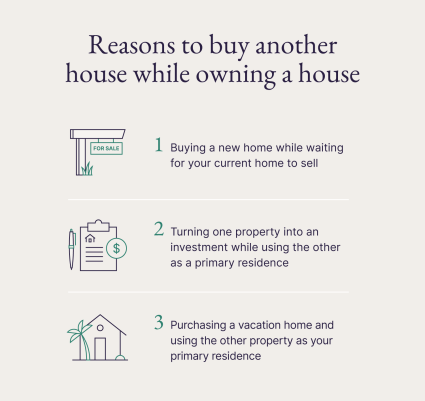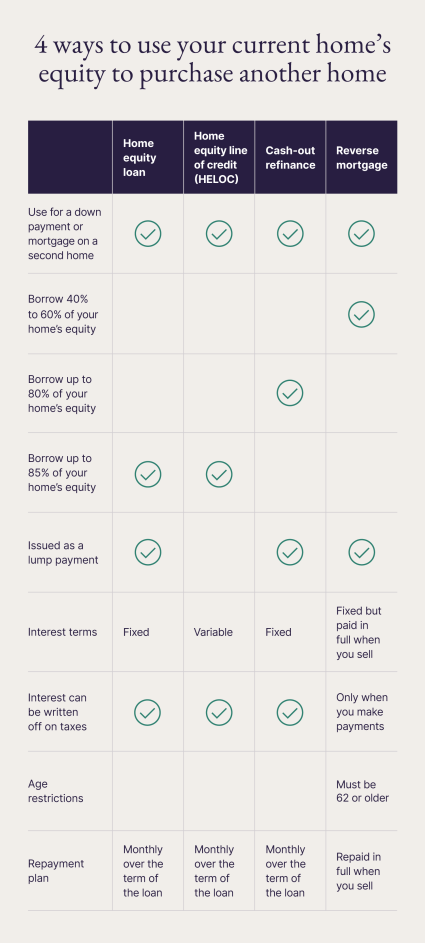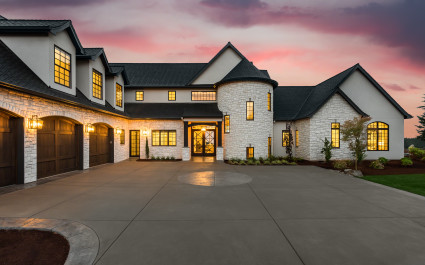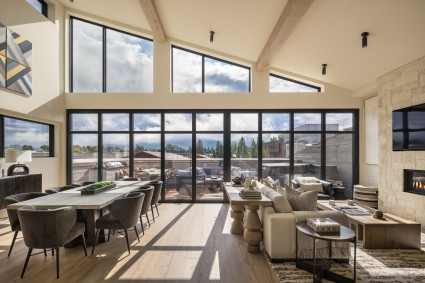
Option 1. Get approved for another mortgage
Best for: When you plan to keep both homes in the long term and already have a down payment. Perhaps the simplest and most familiar strategy for how to buy a house when you own a house is to apply for a new mortgage. In this strategy, a bank approves you to hold two separate mortgages simultaneously. You’ll need to have enough cash on hand to cover a down payment and the closing costs for the new mortgage.| Tip: Use a second home calculator to determine how much money to budget for a second home to help you see whether you can afford two mortgages. |
| Pros | Cons |
|---|---|
| The process is the same as applying for your first mortgage, so it’s familiar. | Tough to qualify due to strict debt-to-income ratio limits and high credit demands. |
| Flexibility to rent or slowly sell current home | Often requires a larger down payment due to limited program eligibility. |
| Potential for tax benefits if the new home is a rental property or a second home. | Dual mortgages mean more paperwork and a longer closing. |
Option 2. Become a landlord
Best for: When you only plan to live in one residence or are buying the second home as an investment.Similar to getting approved for two mortgages, as a landlord you are still responsible for two monthly mortgage payments, but the rental income can help cover your payments. If you plan to rent out your second home, read your mortgage agreement carefully. Some mortgage agreements prohibit you from renting it out or require you to get the lender’s permission. Once you’ve confirmed you can rent out your home, get it appraised to determine how much to charge for rent. The amount you charge should cover your monthly mortgage payment on the property. Your lender may also require you to have at least 2% of the mortgage value in investments, cash, etc., to cover the mortgage if you cannot get a tenant.| Pros | Cons |
|---|---|
| You'll only pay one mortgage out-of-pocket monthly (if you have a tenant). | If your tenant doesn't pay or moves, you'll need to cover the mortgage. |
| You’ll continue to build equity in your first home. | Being a landlord adds responsibilities like listing, showing, and vetting tenants. |
| You can write off rental home improvements and maintenance as business expenses. | Landlord taxes are more complex and require careful record-keeping. |
Option 3. Take out a bridge loan
Best for: When you are buying your new home while selling your current home.A bridge loan is a temporary loan (usually six months to a year) intended to cover the cost of purchasing a new home while waiting for your current home to sell. Also called a swing loan, a bridge loan can finance up to 80% of the value of both your new and current home. When your current home sells, you use the profits to pay back the entirety of the bridge loan and apply for a traditional mortgage for your new home.| Pros | Cons |
|---|---|
| Bridge loans offer quick funding, enabling fast action on new properties in competitive markets. | Bridge loans are difficult to qualify for, requiring excellent credit. |
| You can buy your new home before selling your current one, avoiding temporary housing or rushed sales. | Bridge loans are risky because your current home is collateral; you could lose both properties if it doesn't sell. |
| You can use the bridge loan for renovations to increase your current home's sale value. | Since the housing crash of 2008, many financial institutions have stopped offering bridge loans. |
Option 4. Borrow from your investments
Best for: When you will be responsible for paying two mortgages, whether temporary or in the long term.Generally, you cannot withdraw from your retirement investments without paying a penalty (usually 10%) and potentially taxes on the amount you withdraw. However, you may be able to take out a 401(k) loan to buy a house. Not all providers offer this feature, but if they do, you can generally borrow:- $10,000 or half your vested account balance (whichever is more)
- A total of $50,000
| Pros | Cons |
|---|---|
| Since you're borrowing from yourself, no credit approval or credit check is needed. | Not all 401(k) plans allow you to take out a loan. |
| A 401k loan typically avoids immediate taxes or penalties if repaid on time. | Opportunity costs are high; the money you withdraw isn't invested, reducing your account's long-term earnings. |
| With a 401k loan, you repay yourself, so the "interest" goes back into your own retirement account. | Borrowing limits may only cover a down payment, not the full mortgage amount, for a second home. |

Option 5. Get a home equity loan
Best for: When you will be responsible for paying two mortgages, whether temporary or in the long term.A home equity loan allows you to borrow up to 85% of your current home’s equity. You can use any lender (not just the lender currently serving your mortgage), so shop around and apply for the best rate. Depending on how much equity you have in your home, you may be able to raise enough funds to cover the cost of the mortgage of your second home or the down payment and closing costs.| Pros | Cons |
|---|---|
| Home equity loans let you access cash without using your savings. | A home equity loan uses your primary residence as collateral, putting your home at risk if you default. |
| You can deduct home equity loan interest, similar to a regular mortgage. | You could end up with three monthly loan payments: your original mortgage, the home equity loan for the down payment, and the new home's mortgage. |
| You don't have to sell your current home or refinance its low-interest mortgage. | Home equity loans come with their own closing costs and fees, which can add to the overall expense. |
Option 6. Apply for a home equity line of credit (HELOC)
Best for: When you will be responsible for paying two mortgages, whether temporary or in the long term.A home equity line of credit allows you to borrow against the equity in your home, but it’s not a full balance loan like a home equity loan. Instead, it’s a line of credit you can draw from over time, like a credit card limit. If you have enough equity in your home, you can use your HELOC to cover the entire cost of your new home, or you can just use it for the down payment.| Pros | Cons |
|---|---|
| HELOCs tap into your existing home equity so you can put it toward a second home. | Interest rates are variable, meaning your borrowing rate can change over time. |
| During the draw period, interest-only payments can lower initial monthly costs. | HELOCs often come with closing costs, application fees, and sometimes annual fees, which can add to the overall expense. |
| You can deduct HELOC interest if used to buy, build, or substantially improve a primary or secondary residence, similar to a mortgage. | Like a home equity loan, a HELOC uses your primary residence as collateral, risking your home if you default. |
Option 7. Raise a down payment with a cash-out refinance
Best for: When you will be responsible for paying two mortgages, whether temporary or in the long term.With a cash-out refinance, you refinance the entire value of your home up to 80% of its equity. Whatever you don’t owe on the mortgage, you’ll receive in cash. For example, if you have $100,000 left on your mortgage but the home has $500,000 in equity, you’d be able to refinance up to $400,000. You would walk away with $300,000 in cash to put toward the purchase of your second home.| Pros | Cons |
|---|---|
| Refinancing can reduce your monthly payments if current interest rates are lower than your original mortgage rate. | You may pay a higher rate if current mortgage rates exceed your original rate. |
| If a cash-out refinance covers your second home's full cost, you'll only have one monthly mortgage payment. | Pulling equity from your primary home reduces your built-up equity and increases its loan-to-value (LTV) ratio. |
| The interest on the entire refinanced loan is typically tax-deductible. | Refinancing involves appraisals, underwriting, and closing, a lengthy process compared to other financing. |
Option 8. Consider a reverse mortgage
Best for: Seniors looking to purchase a second homeIf you are 62 or older, you may qualify for a reverse mortgage. Also known as a home equity conversion mortgage (HECM), a reverse mortgage allows you to borrow from your home’s equity without making monthly payments — with the expectation that you will pay back the loan when you sell your home.| Pros | Cons |
|---|---|
| You get access to your equity without extra monthly payments. | Monthly interest accrues and is added to your loan, quickly eroding your home's equity. |
| Reverse mortgage funds are generally tax-free, as they're considered a loan, not income. | Upon your passing, heirs must sell the home to repay the mortgage, reducing their inheritance. |
| You retain the home title, which is crucial if you plan to stay while acquiring another property. | Reverse mortgages require the home to remain your primary residence; moving to a second home could trigger default and make the loan due. |

Option 9. Explore other types of ownership
Best for: People purchasing a vacation home with others.There are other types of home ownership besides sole ownership. If you want to purchase a second home to use as a vacation home while living primarily in your first home, you can choose to purchase a share of a second home. Pacaso transforms second home ownership with a professionally managed co-ownership model. Instead of buying an underused whole home, you purchase a specific share (like 1/8 to 1/2) of a luxury vacation home. Owning with Pacaso isn't a timeshare — it's genuine real estate ownership recorded in a property-specific LLC.| Pros | Cons |
| Splitting purchase and maintenance costs with others makes a second home much more affordable. | You won’t always know the other tenants. |
| Tenants can sell their shares without the permission of other tenants. | You will have to manage a schedule for the occupancy of the home. |
| Ongoing costs are divided among owners, significantly reducing the individual financial burden. | Disagreements can arise over property use, maintenance, finances, or resale. |
Get the best of both worlds with co-ownership
Buying a second home doesn’t have to be a far-off dream. The strategies in this guide can help you raise the cash you need for a down payment or the entire second home mortgage — whether you plan to rent or flip a home, buy a new home while you wait for your current home to sell, or just plan to relax poolside at your vacation home.For those dreaming of that perfect vacation retreat, Pacaso offers a revolutionary, headache-free approach to second home ownership. With Pacaso, you can own a beautifully furnished luxury home in a desirable destination for a fraction of the cost, eliminating the typical hassles of maintenance and management.How to buy another house while owning a house FAQ
01: Can you buy another house while paying a mortgage?
Yes, it is possible to buy another house while still paying a mortgage on your current one. It typically requires stricter financial qualifications, a larger down payment, and careful consideration of various financing options.
02: How does buying a second home affect my taxes?
Buying a second home affects your taxes by potentially allowing deductions for mortgage interest and property taxes. Unlike a primary residence, any profit from selling a second home is typically subject to capital gains tax. How you use the home (personal use vs. rental) significantly impacts available deductions and reporting requirements.
03: Can I co-own a second home while still living in my primary residence?
Yes, you can co-own a second home while still living in your primary residence. This is a common arrangement, especially for vacation properties. It means you'll have shared financial and maintenance responsibilities with the other owners, and your access to the property might be subject to a scheduling agreement.
04: How soon after buying a home can I buy another?
There's no set waiting period after buying one home to purchase another, especially if the second is for rental or investment purposes. However, your ability to buy another home depends heavily on your financial situation, including your credit score, down payment, and debt-to-income (DTI) ratio, since lenders will have higher standards for additional properties.










